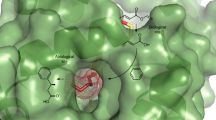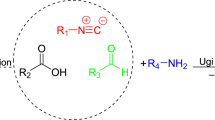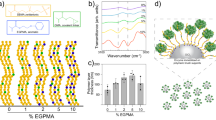Abstract
We have designed a new method for enzyme immobilization using a fusion protein of yeast α-glucosidase containing at its C-terminus a polycationic hexa-arginine fusion peptide. This fusion protein can be directly adsorbed from crude cell extracts on polyanionic matrices in a specific, oriented fashion. Upon noncovalent immobilization by polyionic interactions, the stability of the fusion protein is not affected by pH-, urea-, or thermal-denaturation. Furthermore, the enzymatic properties (specific activity at increasing enzyme concentration, Michaelis constant, or activation energy of the enzymatic reaction) are not influenced by this noncovalent coupling. The operational stability of the coupled enzyme under conditions of continuous substrate conversion is, however, increased significantly compared to the soluble form. Fusion proteins containing polyionic peptide sequences are proposed as versatile tools for the production of immobilized enzyme catalysts.
This is a preview of subscription content, access via your institution
Access options
Subscribe to this journal
Receive 12 print issues and online access
$209.00 per year
only $17.42 per issue
Buy this article
- Purchase on Springer Link
- Instant access to full article PDF
Prices may be subject to local taxes which are calculated during checkout
Similar content being viewed by others
References
Nelson, J.M. and Griffin, E.G. 1916. Adsorption of invertase. J. Am. Chem. Soc. 38: 1109–1115.
Tosa, T., Mori, T., Fuse, N. and Chibata, I. 1967. Studies on continuous enzyme reaction. IV. Preparation of a DEAE-Sephadex-Aminoacylase column and continuous optical resolution of acyl-DL-amino acids. Biotechnol. Bioeng. 9: 603–615.
Janecek, S. 1993. Strategies for obtaining stable enzymes. Process Biochem. 28: 435–445.
Katchalski-Katzir, E. 1993. Immobilized enzymes-learning from past successes and failures. TibTech. 11: 471–478.
Michalon, P., Roche, J., Coutorier, R., Favre-Bonvin, G. and Marion, C. 1993. DNase activity of micrococcal endonuclease covalently immobilized on nylon and polystyrene. Enzyme Microb. Technol. 15: 215–221.
Shankar, V., Nehete, P.N. and Kothari, R.M. 1992. Immobilization of amyloglu-cosidase. Indian J. of Biochem. & Biophys. 30: 62–70.
Ulbrich, R. 1989. Immobilisierte Enzyme, pp. 298–341 in Enzymkatalyse. Schellenberger, A. (ed.). Springer-Verlag, Berlin, Heidelberg, New York.
Leon, J. and Vega, J.M. 1992. Effect of immobilization on the kinetic and stability properties of o-acetyl-l-serine sulfhydrylase from Chlamydomonas reinhardii . Biocatalysis 7: 29–35.
Pilone, M.S., Pollegioni, L. and Buto, S. 1992. Stability and kinetic properties of immobilized Rhodotorula gracilis D-amio acid oxidase. Biotechnol. and Appl. Biochem. 16: 252–262.
Gaikwad, S.M. and Deshpande, V.V. 1992. Immobilization of glucose isomerase on indion 48-R. Enzyme Microb. Technol. 14: 855–858.
Gloger, M. and Tischer, W. 1983. Determination of the catalytic activity of immobilized enzymes, pp. 142–163 in Methods of Enzymatic Analysis, Vol. I, Bergmeyer, H. U., Bergmeyer, J., and GraBI, M. (eds.). Verlag Chemie/Weinheim.
Kopetzki, E., Bucket, P. and Schumacher, G. 1989. Cloning and characterization of baker's yeast α-glucosidase, over-expression in a yeast strain devoid of vacuolar proteinases. Yeast 5: 11–24.
Kopetzki, E., Schumacher, G. and Buckel, P. 1989. Control of formation of active soluble or inactive insoluble baker's yeast α-glucosidase PI in Escherichea coli by induction and growth conditions. Mol. Gen. Genet. 216: 149–155.
Höll-Neugebauer, B., 1992. University of Regensburg.
Höll-Neugebauer, B., Rudolph, R., Schmidt, M. and Buchner, J. 1991. Reconstitution of a heat shock effect in vitro: Influence of GroE on the thermal aggregation of α-glucosidase gram yeast. Biochem. 30: 11609–11614.
Needleman, R.B., Federoff, H.J., Eccleshall, R., Buchferer, B. and Marmur, J. 1978. Purification and characterization of an α-glucosidase from Saccharomyces carlsbergensis . Biochem. 17: 4657–4661.
Halvorson, H. 1966. α-Glucosidase from yeast. Methods in Enzymol. 8: 559–562.
Tabata, S., Ide, T., Umemura, Y. and Torii, K. 1984. Purification and characterization of α-glucosidase produced by Saccharomyces in response to three distinct maltose genes. Biochim. Biophys. Acta 197: 231–238.
Flaschel, E. and Friehs, K. 1993. Improvement of downstream processing of recombinant proteins by means of genetic engineering methods. Biotech. Adv. 11: 31–78.
Sassenfeld, H.M. 1990. Engineering proteins for purification. TibTech 8: 88–93.
Asther, M. and Meunier, J.-C. 1993. Immobilization as a tool for the stabilization of lignin peroxidase produced by Phanerochaete chrysosporium INA-12. Appl. Biochem. and Biotechnol. 38: 57–67.
Sadhukhan, R., Roy, S.K. and Chakrabarty, S.L. 1993. Immobilization of α-amylase from Myceliophthora thermophila D-14 (ATCC 48104). Enzyme Microb. Technol. 15: 801–804.
Martinek, K., Klibanov, A.M., Goldmacher, V.S. and Berecin, I.V. 1977. The principles of enzyme stabilization. I. Increase in thermostability of enzymes covalently bound to a complementary surface of a polymer support in a multipoint fashion. Biochim. Biophys. Acta 485: 1–12.
Mozhaev, V.V., Siksnis, V.A., Torchilin, V.R. and Martinek, K. 1983. Operational stability of copolymerized enzymes at elevated temperatures. Biotechnol. Bioeng. 25: 1937–1945.
Mozhaev, V.V., Melik-Nubarov, N.S., Sergeeva, M.V., Siksnis, V.A. and Martinek, K. 1990. Strategies for stabilizing enzymes. Part one: Increasing stability of enzymes via their multi-point interaction with a support. Biocatalysis 3: 179–187.
Mozhaev, V.V., Martinek, K. and Berezin, I.V. 1979. Effect of immobilization on folding of protein (trypsin). Mol. Biol. 13: 52–57.
Montero, M.A. and Romeu, A. 1993. Properties of almond β-glucosidase immobilized on concanavalin A-sepharose. Biochem. and Mol. Biol. Int. 30: 685–689.
Bode, W., Fehlhammer, H. and Huber, R. 1976. Crystal structure of Bovine Trypsinogen at 1.8 Å resolution. I. Data Collection, application of Patterson search techniques and preliminary structural interpretation. J. Mol. Biol. 106: 325–335.
Padmanabhan, K., Padmanabhan, K.P., Tulinsky, A., Park, C.H., Bode, W., Huber, R., Blankenship, D.T., Cardin, A.D. and Kisiel, W. 1993. Structure of human Des (1–45) Factor Xa at 2.2 Å resolution. J. Mol. Biol. 232: 947–966.
Scott, D.L., White, S.P., Browning, J.L., Rosa, J.J., Gelb, M.H. and Sigler, P.B. 1991. Structure of free and inhibited human secretory Phospholipase A2 from inflammatory exudate. Science 254: 1007–1010.
Stempfer, G., Höll-Neugebauer, B. and Rudolph, R. 1996. Improved refolding of an immobilized fusion protein. Nature Biotechnology. 14: 329–334.
Author information
Authors and Affiliations
Corresponding author
Rights and permissions
About this article
Cite this article
Stempfer, G., Höll-Neugebauer, B., Kopetzki, E. et al. A fusion protein designed for noncovalent immobilization: stability, enzymatic activity, and use in an enzyme reactor. Nat Biotechnol 14, 481–484 (1996). https://doi.org/10.1038/nbt0496-481
Received:
Accepted:
Issue Date:
DOI: https://doi.org/10.1038/nbt0496-481
This article is cited by
-
Biomimetic enzyme nanocomplexes and their use as antidotes and preventive measures for alcohol intoxication
Nature Nanotechnology (2013)
-
Unexpected pathways to protein stabilization
Nature Biotechnology (1996)



